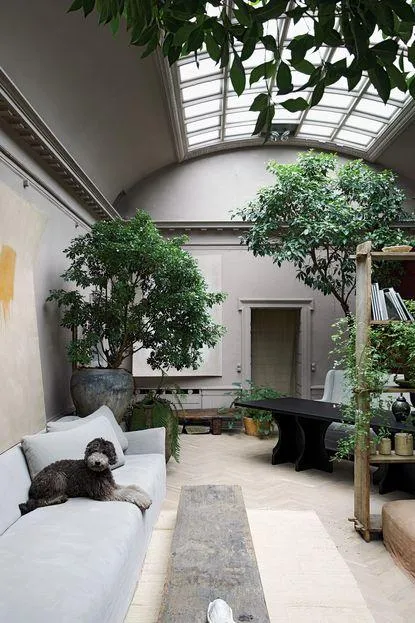Everything You Need to Know About Interior Trees
When searching for “interior trees,” there are likely several questions on your mind. As an interior landscaper, I’ve helped many clients incorporate indoor trees into their homes. In this article, I’ll answer all your burning questions about selecting, caring for, and placing indoor trees.
What Types of Trees Are Best for Indoors?
There are certain tree varieties that adapt much better than others to the indoor environment. When choosing a tree for inside, consider types that are:
- Small and compact – Large, spreading trees aren’t suitable unless you have massive indoor spaces. Stick to bonsai or dwarf varieties.
- Low maintenance – High-care trees may not thrive with indoor conditions. Look for species hardy and resistant to pests/disease.
- Tolerant of low-light – Unless near large windows, many homes lack optimal light levels for plants. Ficus, parlors, and schefflera varieties adapt well.
Some top choices include ficuses, Chinese evergreens, dwarf date palms, parlors, and bonsai trees like junipers. From my experience decorating client homes, ficuses are tough to beat – they’re affordable and can even survive under artificial lights!
How Do I Care for an Indoor Tree?
Caring for a tree inside takes some diligence, but the rewards of green beauty are worth it. Here are the basics:

- Water when the soil is dry 1-2 inches below the surface. Overwatering is a common indoor tree killer.
- Fertilize every few months in the growing season with a diluted, all-purpose houseplant food.
- Prune off any dead or diseased branches and shape the tree as desired.
- Provide as much sun as possible and supplement with grow lights if necessary.
- Dust leaves occasionally and wipe with a damp cloth to remove debris.
- Repot in fresh soil every couple years or when roots fill the container.
Caring for an indoor tree is kind of like caring for yourself – with healthy “habits,” it will thrive. Neglecting its needs and it may look kinda sickly, if you know what I mean.
Where Can I Place an Indoor Tree?
The perfect indoor tree placement relies on your space and the tree’s light needs. Some commonly used spots in homes include:
- Near south- or west-facing windows – Areas that get lots of natural light during the day.
- In a sunny foyer or atrium – High-traffic areas work for showcasing trees.
- In the middle of a living room – Use a tree as a gorgeous central focal point.
- In a reading nook – Trees set the scene for relaxation.
- By a kitchen window – Greenery brightens food prep stations.
- In an office corner – Trees have been scientifically proven to boost productivity and morale!
Be careful of drafty areas near doors/AC vents. Trees also lend visual appeal in bedrooms and bathrooms to feel more like an indoor oasis. But you’ve gotta find what jives with your jam, you know?
What Size Container Do I Need?
Choosing the right container size is important for your tree’s health. As a general rule:

- Start young trees in nursery pots up to 1-2 gallons in size.
- Move them up gradually as they outgrow containers – aim for at least doubling the volume each time.
- Plan on repotting into containers about 2 inches wider than the tree’s branch span.
- Very large specimen trees may need planters or window boxes 10 gallons or bigger.
However, container size also depends on your aesthetic needs. Smaller pots can show off a bonsai tree’s artful shape better. Just make sure the roots have enough elbow room! You wouldn’t want your tree to be all, like, “Bruh I’m feelin’ hella cramped over here.”
How Do I Transport an Indoor Tree Safely?
Whether moving residences or transporting a newly purchased tree, safe transportation is crucial. Here are some tips:
- Wrap the root ball securely in burlap or plastic to keep soil intact.
- Limit root exposure by keeping the tree in its nursery container if possible.
- Support the tree well during transport, ideally laying it on its side with branches braced.
- Shield leaves from wind/sun with a tarp or make multiple trips if necessary.
- Water the tree on the day of transport and again upon arrival at its new home.
- Acclimate it gradually to any changes in conditions at the new location.
If carefully moved, an indoor tree will snap back faster than you can say “pineapple.” Just don’t cram ten trees in your hatchback like I saw some try – talk about chaotic! Better safe than sorry when lugging your leafy pals.
What About Pests and Disease?
While common outdoor tree threats like extreme weather aren’t an issue inside, pests can still pose problems. To help prevent infestations:

- Inspect new acquisitions thoroughly for signs of pests before introducing to your home.
- Isolate fresh trees until you’re sure they’re clean.
- Regularly check leaves, stems and soil for pests like spider mites, aphids or scale.
- Treat minor infestations promptly with soapy water or Neem oil.
- Consult a professional for major pest outbreaks as a precaution.
- Avoid overwatering which can promote root rot and other diseases.
With some attentive care, you can keep your indoor tree healthy as a horse! Let me know if you need any other interior landscaping advice.
Is an Indoor Tree Right for Me?
Only you can decide if incorporating a living tree works with your lifestyle and space. But if you love flora and the soothing presence of greenery, here are a few things to consider:
- Do you have a spot with ample light for a tree species you love?
- Are you willing to stick to a regular care schedule for watering, pruning, etc.?
- Do you seek a lively decorative accent or air-purifying companion plant?
- Is your home/apartment suited size-wise for the types of trees you’re drawn to?
- Will family/pets leave your tree alone and not view it as a chew toy? Heh.
An indoor tree may not be for everyone constantly on the go. But for most homes, some varieties could bring amazing aesthetic touches alongside all the Zen benefits of greenery indoors. Your tree is only an impulse buy away – what do you think, worth a try?
I hope this information helped shed light on all facets of interior trees. Please contact me if you need any other recommendations as you decide. Wishing you the very best in decorating your indoor jungle – whether that includes trees or not! Until next time.

Considerations for Choosing an Interior Tree
| Tree Type | Light Needs | Size | Water Needs | Care Level |
|---|---|---|---|---|
| Peace Lily | Low to Medium | 2-4 feet | Medium | Easy |
| Chinese Evergreen | Low to Medium | 3-6 feet | Medium | Easy |
| Bamboo Palm | Medium | 4-8 feet | Low | Easy |
| Weeping Fig | Medium to High | 2-4 feet | Medium | Moderate |
| English Ivy | Low to Medium | Trailing | Low | Easy |
| Parlor Palm | Low to Medium | 3-6 feet | Medium | Easy |
FAQ
- How big can interior trees get? Interior trees can reach different sizes based on the variety, but for the most part they don’t grow as large as outdoor trees due to limited sunlight. Typically indoor trees max out at around 8-10 feet tall.
- Do interior trees need direct sun? While direct sun is not completely necessary, interior trees generally do best when positioned in a spot that gets some direct sunlight every day. At the very least, they need a bright window with indirect light for several hours.
- What kinds of trees do well inside? Some tree varieties that commonly do well indoors include the Money Tree, Dracaena, Chinese Evergreen, Rubber Plant, Dwarf Umbrella Tree, and Weeping Fig. According to experts, these ones can tolerate varying light conditions and domestic temperatures.
- How often do you water an interior tree? The watering needs will depend on the size of the pot and plant, as well as environmental factors. As a general rule, check the soil moisture daily by sticking your finger an inch into the soil. Water when the top inch feels dry.
- Do indoor trees need fertilizer? While fertilizer isn’t completely necessary, using a diluted liquid houseplant fertilizer during the growing season from Spring to Fall can boost an interior tree’s growth. I’d follow fertilizer instructions carefully so as not to harm the plant.
- Is it hard to care for an interior tree? With the right variety and care routine, interior trees are pretty low maintenance. The toughest part might be finding that sweet spot with light, water, and fertilizer. But it’s well worth it for the amazing way a tree can spruce up a home!
- What are some potential issues with indoor trees? Pests like spider mites and scale can sometimes plague interior trees. Also, overwatering is a common problem that can lead to root rot. Good airflow and a well-draining potting mix can help mitigate these problems. Regular inspections for signs of stress are key to long-term care.
